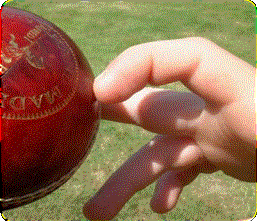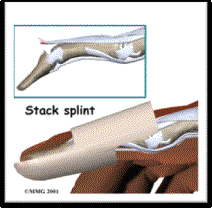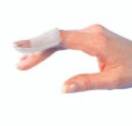Mallet finger
 How do I know if I have a mallet finger?
How do I know if I have a mallet finger?
Mallet fingers are typically due to an impact onto the tip of the finger, such as catching cricket ball or while playing basket ball. Examination of the tendon will show that you cannot straighten the joint at the end of the finger. It will be swollen and painful but it will be able to bend or flex. The tendon which pulls on the bone to straighten the joint has torn and ruptured. The tendon can sometimes pull off a small fragment of bone with it.
Mallet finger can also occur as a result of a cut across the back of the joint. In this case a sharp object has cut the tendon and in the same way can no longer straighten the tip of the finger.
 What is mallet finger?
What is mallet finger?
You have torn a tendon or 'leader' which straightens the end joint of your finger. This is called a Mallet injury. To treat this, the joint must be held straight in a plastic splint for 6-8 weeks, as the tendon heals very slowly. If the finger tip is allowed to bend during this time, healing will not take place and the droop of your finger will be permanent. The splint should therefore only be removed for cleaning.
Your finger droops because the tendon to extend it has snapped. The treatment is to prevent the finger tip from dropping for a minimum of 6-8 weeks by applying the splint. If the tendon has been cut then an operation is necessary. This will involve a local anaesthetic and a suture repair of the tendon, followed by routine splinting as described below.
How to clean your splinted finger
- our splinted finger must be kept clean and dry at all times. If the skin becomes wet inside the splint it will become very sore. Leave the splint undisturbed except when cleaning your finger which you should do once daily.
- Keeping your finger flat on the table cut the strapping and peel it away from the finger and splint:
- Carefully slide the splint off your finger.
- Wash and dry your finger, also the splint with your free hand. If you are unable to do this please ask for help.

Keep the end joint of your finger straight at all times
Do not let it bend even for a moment.
- Keep your finger flat on the table while washing or support it using your other hand or thumb
- You may use a little talcum powder on your finger and the splint if you wish.
- Slide the splint back over the finger tip, still keeping your finger straight, so that the finger tip fits snugly into the end of the splint.
- Replace the strapping to anchor the splint into position.
Complications
- Failure of the tendon to heal can occur in 5-10% of cases; infection, delay in treatment or patient non-compliance are all factors which can contribute to this.
- Tendon adhesion because of the swelling and subsequent scar tissue formation tendon adhesions may occur. The tendons get stuck down and do not slide very well so that flexion of the joint is reduced.
- Joint stiffness Joints in the region can become stiff even if not directly injured as a result of factors such as swelling, infection and immobility. In the majority of patients the loss of movement is minor. In some, however, further surgery is required to release the joint.



